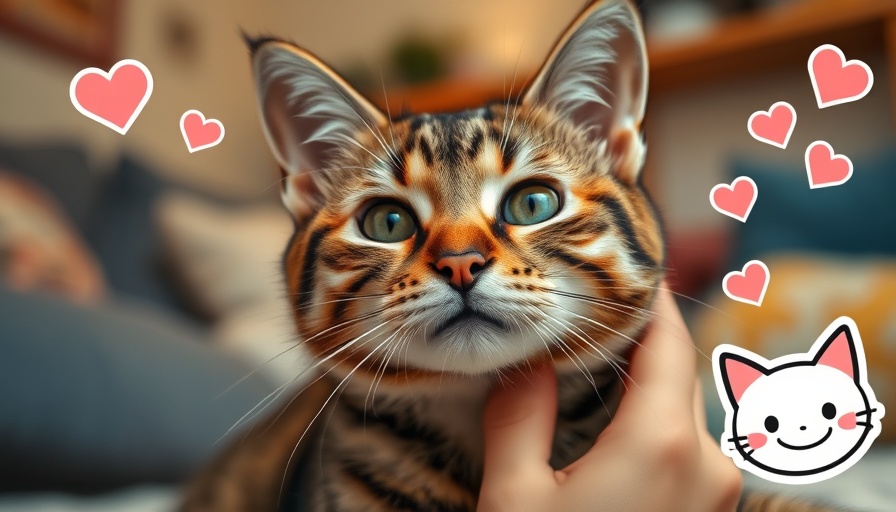
Understanding Your Feline Friend: More Than Just Meows
Cats often feel like mysterious creatures with their enigmatic personalities and behavioral quirks. These furry companions are more than just pets; they are beings with a rich emotional life waiting to be explored. By honing in on the ways cats communicate, we can significantly enhance our relationships with them and ensure their well-being.
The Language of Cats: What to Look For
While many humans communicate verbally, cats rely heavily on body language, vocalizations, and behaviors to express their feelings and desires. Experts assert that effectively reading these signs is crucial for deepening the human-animal bond. According to Dr. Jeannine Berger, prestigious veterinarian and researcher, cats communicate their needs primarily through their bodies—specifically the positioning of their tails, ears, and even their eyes.
For instance, a cat with a high-held tail is generally happy, while a tail tucked between its legs signifies fear or submission. Similarly, the position of their ears can tell you whether your kitty is calm, curious, or agitated. A cat's eyes not only communicate interest but can also express affection or distrust; slow blinking may indicate that your cat feels safe and secure in your presence.
Vocalizations: The Echo of Expression
Vocal sounds are another primary method of cat communication. From soft purrs to demanding yowls, the pitch, tone, and length of a cat's meow can indicate a plethora of emotions ranging from contentment to frustration. It's fascinating to learn how cats modify their vocalizations specifically to elicit reactions from humans, adapting their sound to suit their needs—like hunger or attention.
Indeed, studies suggest that pet owners report higher levels of stress relief and satisfaction when they attune themselves to their cats' unique vocal cues. Understanding these nuances can help prevent miscommunication and improve overall pet health and happiness.
Non-verbal Signals: Actions Speak Louder
Beyond vocalizations and body language, cats exhibit other behavioral traits that can signal their wellness or distress. Kneading, known affectionately as “making biscuits,” is one such behavior. Kittens perform this action early in life to stimulate their mother's milk flow. As adults, cats may knead to show comfort and happiness—often associated with relaxation during cuddles or while being petted.
Yet, if a cat suddenly stops these affectionate behaviors or displays aggression, it could indicate underlying health issues that need addressing. Therefore, paying close attention to changes in behavior is pivotal for pet health, watching for signs of discomfort or stress.
Building a Language of Understanding
The relationship we have with our pets is like any other; it thrives on communication, understanding, and connection. By learning the various ways our furry friends express themselves, we can create stronger bonds that lead to healthier and happier lives for both human and cat. It is not only important for enhancing our connections but also critical for ensuring pet wellness and preventing common medical issues that can arise from misunderstanding behavioral cues.
So, how can we cultivate this understanding? Start by spending quality time with your cat. Observe their habits, their quirky behaviors, and their responses to different stimuli. By being actively engaged, you can become more attuned to their needs and emotions.
Comparative Analysis: Dogs vs. Cats
It’s important to note the differences in communication between dogs and cats. While dogs also use vocalizations and body language, they tend to be more expressive and eager to please, often relying on playful interactions to communicate bonding or need for exercise. Cats, on the other hand, lean towards subtler forms of expressing their wants, leading us to sometimes overlook their signals.
Understanding these differences can enhance the health and exercise regimen of both pets. Creating tailored activities according to your pet's unique communication style can help keep them physically active and mentally stimulated.
Final Thoughts: Bridging the Understanding Gap
Recognizing your pet’s communication style is an empowering step toward a more fulfilling relationship. By embracing the nuances of feline and canine communication, pet owners can better cater to their pets' needs, ensuring pet health and fostering deeper emotional connections.
As we strive to improve our understanding, we cultivate an environment where our pets feel secure and loved—a true testament to the human-animal bond that enriches our lives.
 Add Row
Add Row  Add
Add 




 Add Row
Add Row 


 Add
Add
Write A Comment